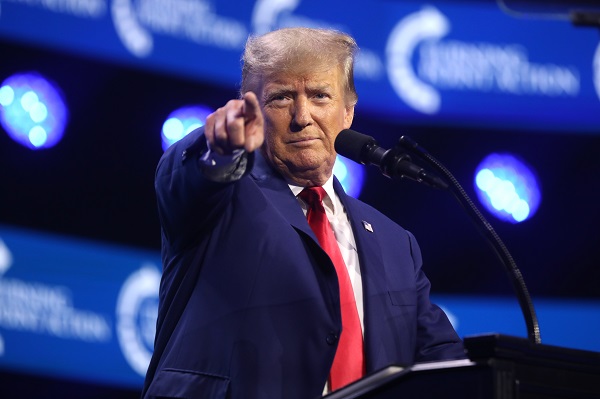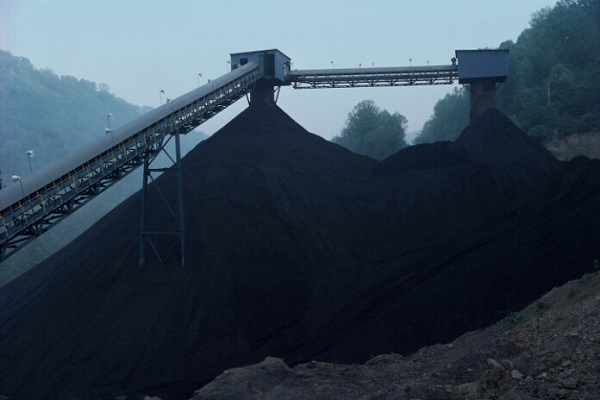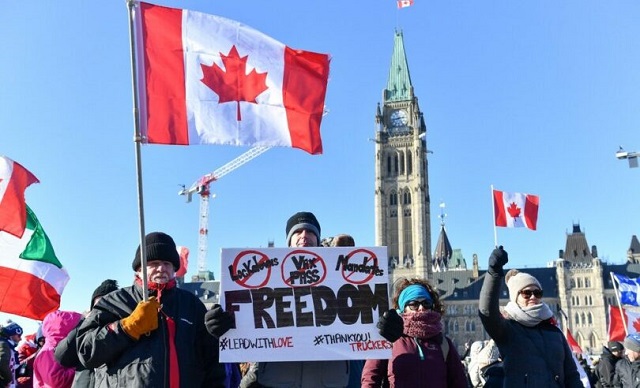Economy
Trump Could Bring Back “America First”. What Could Happen to Canada’s Natural Resource Exports?

From EnergyNow.ca
A second Trump presidency likely means more tariffs, and Canada’s energy and forestry sectors will feel the impact.
As the passing of former Prime Minister Brian Mulroney was reported, we thought back to his ratification of the North American Free Trade Agreement (NAFTA) with the United States and Mexico.
The question now is: If Donald Trump becomes the next President of the U.S., what happens to the U.S.-Mexico-Canada Agreement (USMCA) of 2020? The USMCA came after Trump threatened to pull out of NAFTA in 2018.
On Monday, the Supreme Court of the United States recently overturned a ruling from the Colorado Supreme Court that barred Trump from appearing on the ballot during the 2024 presidential election, clearing a major obstacle in his goal of once again winning the presidency in November.
If Trump does win again in November, stand by for round two of the “America First” campaign of his first term.
“After decades of the status quo, President Trump has made it clear that Americans will no longer take back seat to the rest of the world,” said Ken Farnaso, who was a deputy national press secretary during Trump’s ultimately unsuccessful 2020 re-election campaign.
So prepare, for starters, for a 10 percent tariff on imports into the U.S. — and Canada is the second largest source of those imports.
Trump’s promised tariffs would hammer Canadian exports to the U.S. In 2021 (the latest figures we see), those exports were worth $355 billion, including oil ($78.8 billion), automobiles ($26.4 billion), and natural gas ($13.4 billion).
What would Trump do about increased exports of Canadian oil to the U.S. through the Trans Mountain Expansion Project? What about our natural-gas exports, which have helped the U.S. become the world’s biggest exporter of liquefied natural gas (LNG)?
And a Trump presidency would undoubtedly mean more trouble for Canada’s forestry sector. It has long been fighting “entirely unwarranted,” U.S. tariffs on our softwood lumber — and now has been told that America will soon boost the border-crossing charges to 13.86 percent, up from 8.05 percent.
(Under the U.S. Tariff Act, the Department of Commerce determines whether goods are being sold at less than fair value or if they’re benefiting from subsidies provided by foreign governments. U.S. producers insist that provincial stumpage fees are so low as to amount to an unfair subsidy.)
And on foreign affairs, note Trump’s tough promise for China: tariffs of 60 percent or higher on imported Chinese goods. And, he has added, “Maybe it’s going to be more than that.”
This comes after the trade war he triggered during his first term as president when he imposed $250 billion in China tariffs. That disrupted the global economy, hammered consumers, and hit stock markets.
U.S. stock-market watchers have shuddered at this new promise. Nikki Haley, who suspended her campaign for the Republican nomination on Wednesday morning, has said: “What Donald Trump’s about to do, is he’s going to raise every (American) household’s expenses by $2,600 a year.”
Trump has said nothing about current U.S.-Canada relations, but has in the past declared:
- “We lose with Canada — big-league. Tremendous, tremendous trade deficits with Canada.”
- “Canada has been very difficult to deal with. . . . They’re very spoiled.”
-
“Canada, what they’ve done to our dairy farm workers, it’s a disgrace.”
Roland Paris, a Canada-based associate fellow of the U.S. and the Americas Program writes:
“ Canada is not the only country bracing for Donald Trump’s possible return to the White House – but few have more at stake.”
“Three-quarters of Canada’s goods exports, accounting for more than one-quarter of the country’s gross domestic product, go to the U.S. Given Trump’s impulsiveness and deeply protectionist instincts, Canada’s business and political leaders are understandably nervous.”
Prime Minister Justin Trudeau told business leaders in Montreal: “It wasn’t easy the first time, and if there is a second time, it won’t be easy either.”
Indeed. If the second time begins with Trump being elected on November 5, and sworn in on January 20, 2025, it could be a nasty case of “Oh, Canada.”
Automotive
Governments in Canada accelerate EV ‘investments’ as automakers reverse course

From the Fraser Institute
Evidence continues to accrue that many of these “investments,” which are ultimately of course taxpayer funded, are risky ventures indeed.
Even as the much-vaunted electric vehicle (EV) transition slams into stiff headwinds, the Trudeau government and Ontario’s Ford government will pour another $5 billion in subsidies into Honda, which plans to build an EV battery plant and manufacture EVs in Ontario.
This comes on top of a long list of other such “investments” including $15 billion for Stellantis and LG Energy Solution, $13 billion for Volkswagen (with a real cost to Ottawa of $16.3 billion, per the Parliamentary Budget Officer), a combined $4.24 billion (federal/Quebec split) to Northvolt, a Swedish battery maker, and a combined $644 million (federal/Quebec split) to Ford Motor Company to build a cathode manufacturing plant in Quebec.
All this government subsidizing is of course meant to help remake the automobile, with the Trudeau government mandating that 100 per cent of new passenger vehicles and light trucks sold in Canada be zero-emission by 2035. But evidence continues to accrue that many of these “investments,” which are ultimately of course taxpayer funded, are risky ventures indeed.
As the Wall Street Journal notes, Tesla, the biggest EV maker in the United States, has seen its share prices plummet (down 41 per cent this year) as the company struggles to sell its vehicles at the pace of previous years when first-adopters jumped into the EV market. Some would-be EV makers or users are postponing their own EV investments. Ford has killed it’s electric F-150 pickup truck, Hertz is dumping one-third of its fleet of EV rental vehicles, and Swedish EV company Polestar dropped 15 per cent of its global work force while Tesla is cutting 10 per cent of its global staff.
And in the U.S., a much larger potential market for EVs, a recent Gallup poll shows a market turning frosty. The percentage of Americans polled by Gallup who said they’re seriously considering buying an EV has been declining from 12 per cent in 2023 to 9 per cent in 2024. Even more troubling for would-be EV sellers is that only 35 per cent of poll respondents in 2024 said they “might consider” buying an EV in the future. That number is down from 43 per cent in 2023.
Overall, according to Gallup, “less than half of adults, 44 per cent, now say they are either seriously considering or might consider buying an EV in the future, down from 55 per cent in 2023, while the proportion not intending to buy one has increased from 41 per cent to 48 per cent.” In other words, in a future where government wants sellers to only sell EVs, almost half the U.S. public doesn’t want to buy one.
And yet, Canada’s governments are hitting the gas pedal on EVs, putting the hard-earned capital of Canadian taxpayers at significant risk. A smart government would have its finger in the wind and would slow down when faced with road bumps. It might even reset its GPS and change the course of its 2035 EV mandate for vehicles few motorists want to buy.
Author:
Automotive
Red States Sue California and the Biden Administration to Halt Electric Truck Mandates

From Heartland Daily News
By Nick Pope
“California and an unaccountable EPA are trying to transform our national trucking industry and supply chain infrastructure. This effort—coming at a time of heightened inflation and with an already-strained electrical grid—will devastate the trucking and logistics industry, raise prices for customers, and impact untold number of jobs across Nebraska and the country”
Large coalitions of red states are suing regulators in Washington, D.C., and California over rules designed to effectively require increases in electric vehicle (EV) adoption.
Nebraska is leading a 24-state coalition in a lawsuit against the Environmental Protection Agency’s (EPA) recently-finalized emissions standards for heavy-duty vehicles in the U.S. Court of Appeals for the D.C. Circuit, and a 17-state coalition suing the state of California in the U.S. District Court for the Eastern District of California over its Advanced Clean Fleet rules. Both regulations would increase the number of heavy-duty EVs on the road, a development that could cause serious disruptions and cost increases across the U.S. economy, as supply chain and trucking sector experts have previously told the Daily Caller News Foundation.
“California and an unaccountable EPA are trying to transform our national trucking industry and supply chain infrastructure. This effort—coming at a time of heightened inflation and with an already-strained electrical grid—will devastate the trucking and logistics industry, raise prices for customers, and impact untold number of jobs across Nebraska and the country,” Republican Nebraska Attorney General Mike Hilgers said in a statement. “Neither California nor the EPA has the constitutional power to dictate these nationwide rules to Americans. I am proud to lead our efforts to stop these unconstitutional attempts to remake our economy and am grateful to our sister states for joining our coalitions.”
(RELATED: New Analysis Shows Just How Bad Electric Trucks Are For Business)
While specifics vary depending on the type of heavy-duty vehicle, EPA’s emissions standards will effectively mandate that EVs make up 60% of new urban delivery trucks and 25% of long-haul tractors sold by 2032, according to The Wall Street Journal. The agency has also pushed aggressive emissions standards for light- and medium-duty vehicles that will similarly force an increase in EVs’ share of new car sales over the next decade.
California’s Advanced Clean Fleet rules, meanwhile, will require that 100% of trucks sold in the state will be zero-emissions models starting in 2036, according to the California Air Resources Board (CARB). While not federal, the California rules are of importance to other states because there are numerous other states who follow California’s emissions standards, which can be tighter than those required by the EPA and other federal agencies.
Critics fear that this dynamic will effectively enable California to set national policies and nudge manufacturers in the direction of EVs at a greater rate and scale than the Biden administration is pursuing.
Trucking industry and supply chain experts have previously told the DCNF that both regulations threaten to cause serious problems for the country’s supply chains and wider economy given that the technology for electric and zero-emissions trucks is simply not yet ready to be mandated at scale, among other issues.
Neither CARB nor the EPA responded immediately to requests for comment.
Nick Pope is a contributor to The Daily Caller News Service.
Originally published by The Daily Caller. Republished with permission.
-

 Uncategorized2 days ago
Uncategorized2 days agoRCMP recruitment failure has Alberta advocacy group calling for Provincial Police Service
-

 Automotive19 hours ago
Automotive19 hours agoGovernments in Canada accelerate EV ‘investments’ as automakers reverse course
-

 COVID-191 day ago
COVID-191 day agoJapan’s most senior cancer doctor: COVID shots are ‘essentially murder’
-

 Health2 days ago
Health2 days agoPrivate Footage Reveals Leading Medical Org’s Efforts To ‘Normalize’ Gender Ideology
-

 Health13 hours ago
Health13 hours agoSouth Korean president declares low birth rate a ‘national emergency,’ plans new ministry to address it
-

 Economy22 hours ago
Economy22 hours agoBiden signs suicidal ‘No Coal’ pact, while rest of world builds 1,000 new plants
-

 Health2 days ago
Health2 days agoTHE WPATH TAPES: Behind-The-Scenes Recordings Reveal What Top Gender Doctors Really Think About Sex Change Procedures
-

 COVID-192 days ago
COVID-192 days agoTrudeau government only sought legal advice after Emergencies Act was invoked, records indicate








